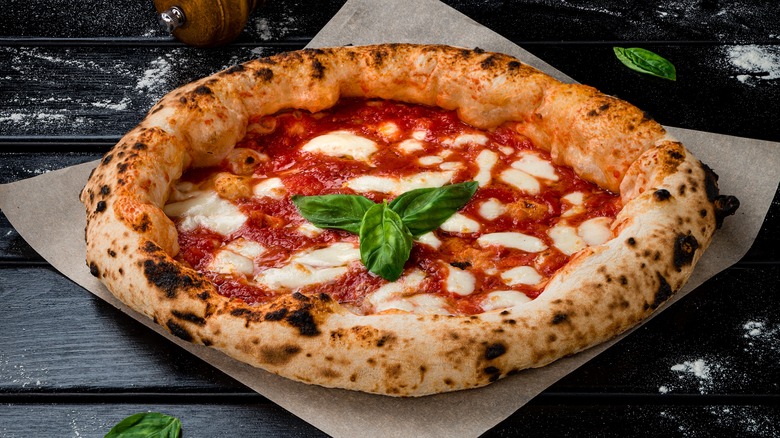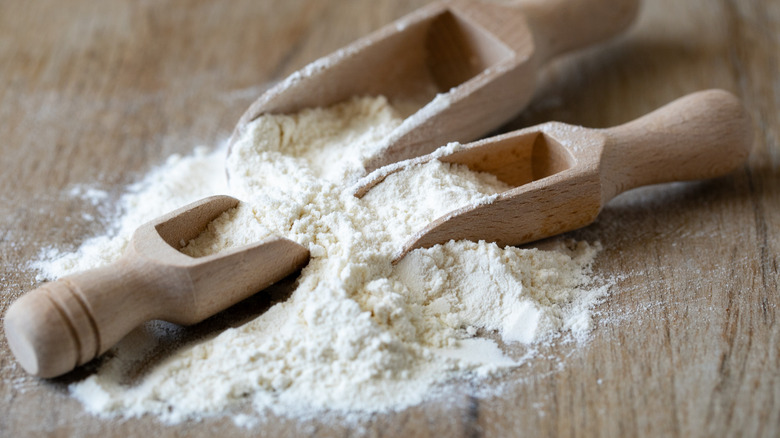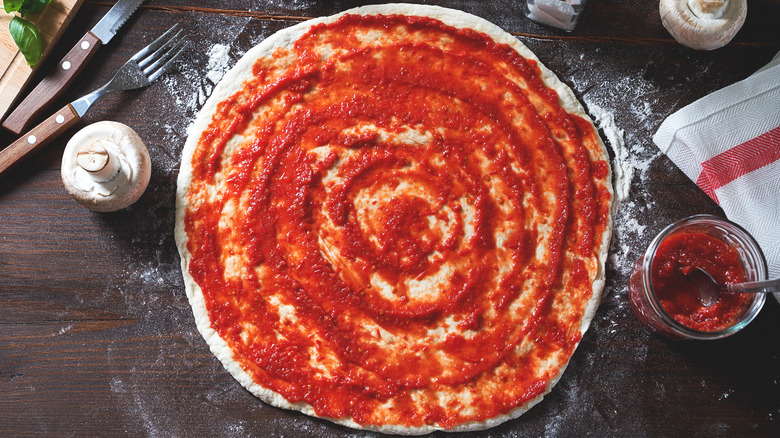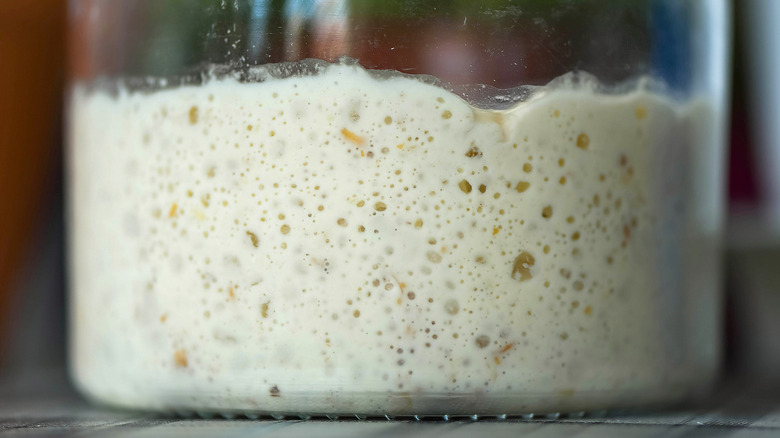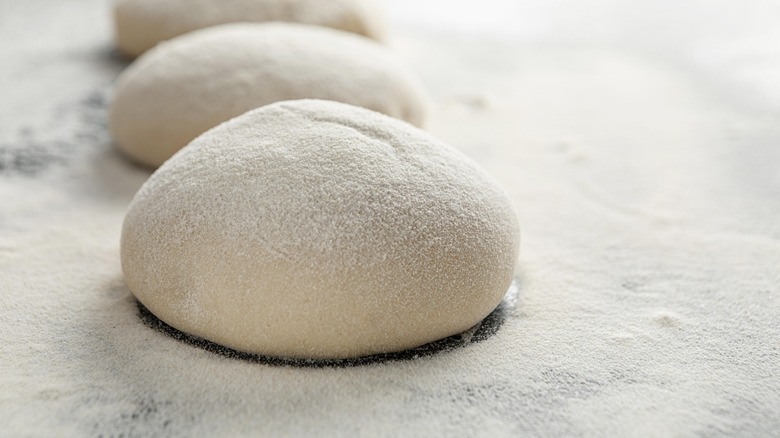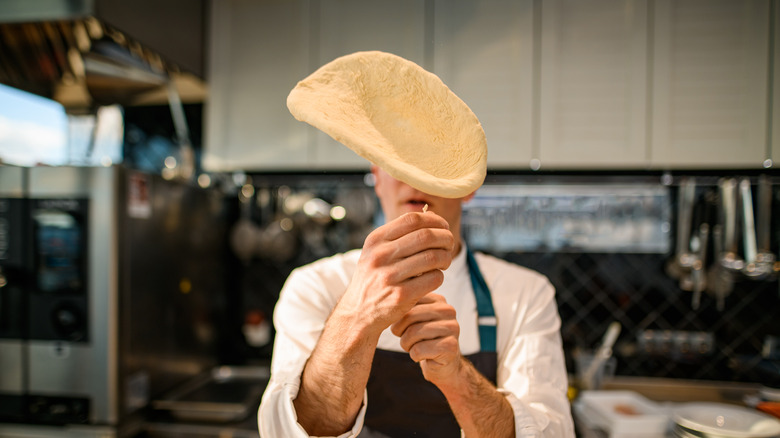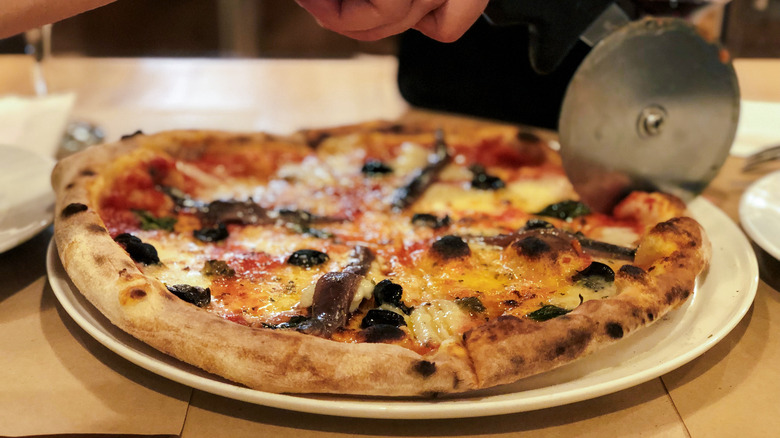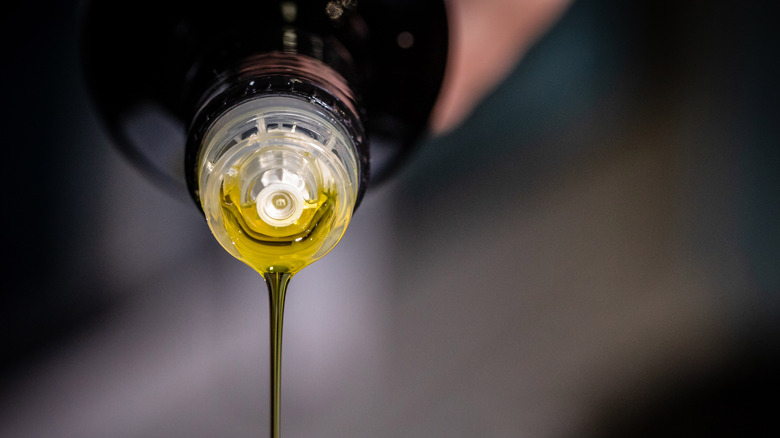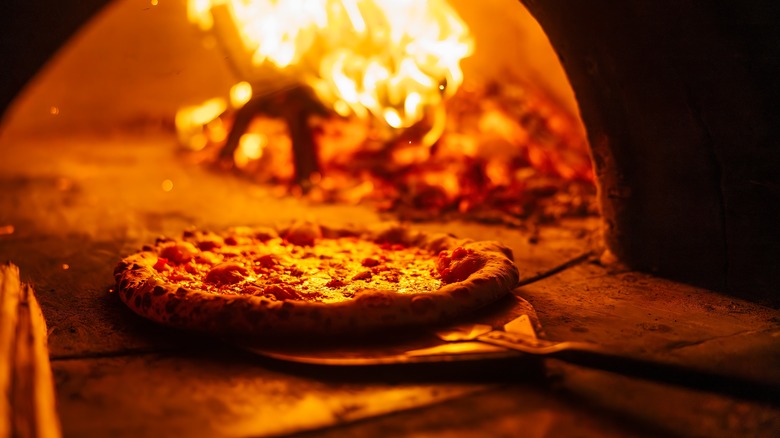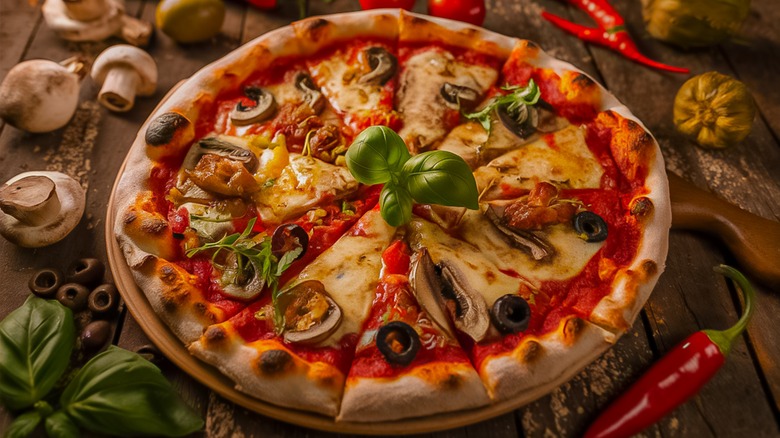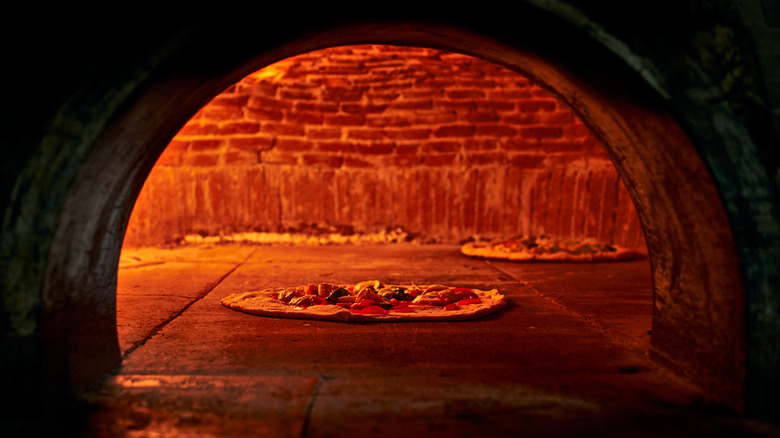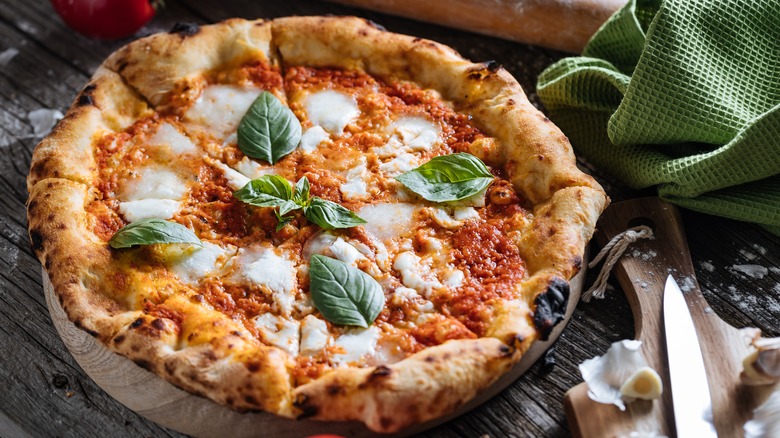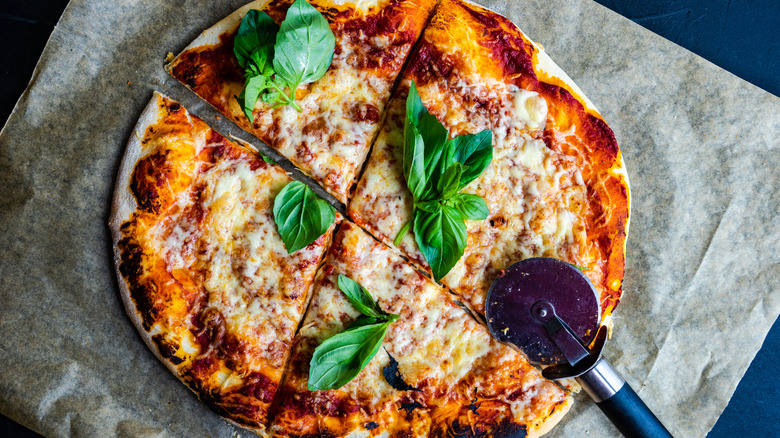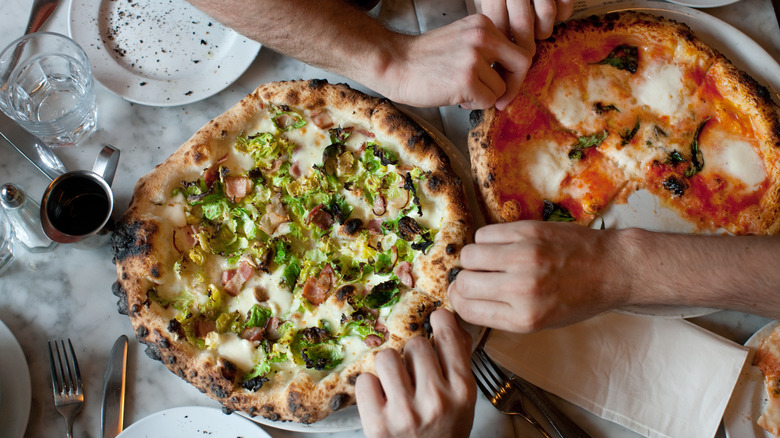Why Pizza Always Tastes Better At A Restaurant Vs At Home
There's nothing quite like a perfectly cooked pizza. It is the ultimate marriage of textures, flavors, economy, and speed: In just a few minutes, with just a few ingredients, you can have a dish that's bursting with flavor and is crunchy, soft, squidgy, and stretchy. Unfortunately, though, if you've ever tried to make one at home, you'll know how difficult it can be. Suddenly, a dish that on its surface is no more than bread, sauce, and a few toppings becomes boring and flat-tasting. The reason for this is that while pizza might be simple, the art of making it is something that takes years to perfect.
While working in a Neapolitan pizza joint for years, I learned first-hand what goes into making incredible pizza. While some elements of pizza-making might require more specialized ingredients or equipment, a lot of these tips can be incorporated into your homemade pizzas. Ready to make the best 'za of your life? I'm here to lay out exactly how the pros do it.
They use the best ingredients possible
If you've ever eaten authentically-made pizza, you'll know how dynamite it is — and yet, the best pizzas always seem to be simple. So how do pizzerias extract so much flavor from such few elements? Well, every ingredient they use is usually the best-quality they can source. You can tell a good pizzeria from a bad one by the ingredients they use, and when they're made with rigorously-sourced, artisan-made items, they're pretty much bursting with flavor and quality.
In my experience, 00 flour is the best choice for a Neapolitan pizza, whether it's homemade or made in a restaurant. 00 flour is an incredibly fine-milled flour made from soft wheat, with a high protein content. These elements all tie together to make the perfect base. The fine milling and softer wheat gives it a tender texture, while the protein content allows it to hold its structure during the fermentation process. For the tomato base, DOP San Marzano tomatoes are a must: They have a gently sweet, gently savory flavor with a touch of acid that brings the two elements together. For the cheese, we preferred to use carefully-sourced fior di latte mozzarella, which has a fresh, milky flavor. If you can't find any of these, you can just go for the best quality you can grab — but trust me, it makes all the difference.
The tomato sauce is super simple
There are a million recipes for pizza sauce out there, and honestly, most of them are way too complicated. A good pizza sauce requires good tomatoes — and that's kinda it. The best chefs know that pizza sauce requires little more than crushed tomatoes with a pinch of salt added to them. If I dared to suggest adding any more ingredients into the sauce to the chefs I worked with, I'd be greeted with a raised eyebrow and a shake of the head.
Using just the tomatoes, with a touch of salt to enhance them, allows their inherent flavor to shine through. San Marzano tomatoes are positively bursting with flavor, and their intensity means that you don't need anything else. Plus, if you start adding herbs, spices, sugar, or other seasonings to your tomato sauce, you prevent it from being the uncomplicated base ingredient you need it to be, the bed upon which all of your other flavorful toppings lie. If you want to go down the ultra-authentic route, you can crush your tomatoes by hand. While this isn't essential (personally speaking, we blended ours), it can give your sauce a gloriously chunky texture. If you want your sauce to be totally delicious, too, do yourself a favor and stop cooking it.
They usually have an in-house sourdough starter
Any baker will tell you that good bread takes a lot of work, and pizza chefs wouldn't disagree. While some make-at-home recipes instruct you to make the dough and immediately throw toppings onto it, this can be a direct route to a flavorless 'za. Instead, you need to pay as much attention to your dough as you would to any other ingredient — and if you're working with sourdough, that means grabbing yourself a good starter.
In my restaurant, we had an in-house sourdough starter, affectionately called "the mother." This mama would supply all of the sourdough in my branch and the other branches of the restaurant. We used this instead of a yeast starter not just to keep our flavors consistent across the various restaurants, but because it gave our dough a complex, nutty flavor. This starter was fed periodically with flour and water to keep it alive and active.
Then, once the sourdough starter did its work, it was time to make the dough. The starter was mixed with flour, water, and salt, and the dough was on its way. Crucially, though, not all pizza is made from sourdough, so don't worry if you can't get hold of a starter. Just remember that your pizza base shouldn't be the thing you think about least in your recipe.
The dough is mixed and proofed properly
Whether you're making sourdough pizza or working with a more typical pizza dough recipe, mixing and proofing it is an essential part of the process. You'll want to make sure that your dough is well-combined and consistent without overworking it, as this can toughen up its gluten strands and make it chewier. For sourdough, the process of mixing and proofing can be pretty complex — but in my experience, it makes the best pizza out there.
End-to-end, the process of making the dough in the restaurant I worked in took several days. After the dough was combined using the starter and other ingredients and mixed together (which took place in an enormous dough mixer — we made a lot of pizza), it was left briefly to rest, which kick-started it's fermentation process. Then, the dough was weighed, formed into balls, and put in the fridge to proof for up to two days. Slow-proofing the dough at a low temperature developed its gluten structures and made it airer and chewier. It also gave it a more complex, subtle flavor. Naturally, most home chefs won't want to go through such a lengthy process. If you do, though, you're certain to be rewarded.
The stretching process is more complicated than you think
There's a reason that pizza chefs throw their dough into the air to stretch it out, and it's not just because it looks incredibly cool. Stretching pizza by throwing it in the air in a circular motion is one of the best ways to gently stretch it (provided that you throw your pizza dough correctly). As the dough spins, it slowly but surely spreads out in an even circle, and gives the base a flat, consistent surface.
While you can definitely stretch out dough by pressing down on a flat countertop, doing so can be a little riskier. When you introduce downward pressure to the dough, you increase the likelihood of being too forceful and ripping it. Furthermore, it can be trickier to make it consistently flat. The best way to stretch dough on a countertop is by lightly flouring it, and then working with the heels of your hands, gently pressing it from the center outward while spinning the dough around. If the dough starts to feel too thin, stop and fold it over on itself before starting again.
Restaurant toppings are prepared carefully
It's not just the dough and sauce that gets careful treatment in pizza restaurants: The toppings do too. The way you prepare your toppings is as important as the ones you choose. Aside from the sheer quality of your toppings, the most important thing to consider is moisture. If the items you add to your pizza are overly moist, as they cook they will release water into the pizza. In the restaurant I worked in, the vegetables were intentionally dried out slightly, to ensure that they don't release too much water, and things like anchovies, capers, and anything else that came in brine were thoroughly drained.
Size was also a crucial component to consider with the toppings. In our restaurant, it was important that every topping was roughly the same size as each other and could be eaten in one bite. If one topping starts to dominate the pizza, it just becomes a struggle to eat — and you risk dragging the other toppings and cheese off the slice when you try to chomp through the topping with your teeth.
Chefs add oil after the sauce
When do you add oil to your pizza? Some folks drizzle it onto the pizza base before they add the sauce. Others add it after the pizza's cooked as a final topping before they eat. While there's no one fixed way to do things, in my opinion the best way to go about things is to work in this order: Sauce first, oil second.
In the restaurant I worked in, oil was added as a quick drizzle over the sauce, instead of as a base on the pizza. This oil (which was, as you might expect, olive oil) added a huge amount of rich, lightly fruity flavor to the pizza. The toppings were then dotted on top, and the pizza went into the oven. The only exception to this order was if there was a pizza that used a flavored oil, like garlic or truffle oil: Those would be added once the pizza came out of the oven to retain the oil's taste and fragrance.
This technique created the perfect balance of sauce to fat and kept things well-incorporated. If you add the oil beforehand, you create a slight barrier between the pizza and the sauce, which can then result in your toppings and sauce sliding off when you pick up your first slice. Don't be afraid to add a good glug of oil, either. It's more flavor, after all.
Chefs have perfected the art of the peel
You eat with your eyes as much as your mouth, and in order to keep the dough as circular as possible, restaurant chefs get very skilled at using the peel. "Peel" is the name for what most folks might call the pizza paddle. Chefs sweep the pizza onto it in one fluid motion (often dipping the peel in flour beforehand to help it get under the pizza), and then shimmy it into the oven to keep its shape. Crucially, they also get the pizza onto the peel as soon as possible — if you leave a topped, raw pizza on the side, it quickly glues to the surface and you can't get it into the oven without ripping it.
Unfortunately, when making pizzas at home, getting them into the oven, or onto your pizza stone, is an overlooked step. Improper technique with a peel can lead to pizzas becoming misshapen, which makes them look pretty untidy. More than that, though, knocking your pizza out of shape can also unbalance its toppings, leaving you with a pizza that tastes totally different depending on the bite you take. It pays to grab yourself a small peel to make the transfer from counter to cooker.
In restaurants, the toppings are added sparingly
Look, here's the thing, we're not gonna deny that there's a pleasure in a pizza bulging with toppings. However, one of the key differences between how they're made in restaurants and how they're made at home is that restaurant chefs understand the importance of proportions. In restaurants, they usually don't add loads of toppings to pizzas — in fact, the chefs sort of hate it when you do! When you add loads of toppings, it weakens the structure of the dough and prevents the bottom from cooking properly. It also increases the chance that the pizza will fall apart in the oven, and makes it more difficult to maneuver.
Aside from this, throwing loads of toppings on your pizzas also makes them taste messy and confusing, and doesn't allow the quality ingredients to shine through. That's why most chefs will stick to two or three key toppings per pizza. If you're adding more than that, you have to make sure you're putting on less of each ingredient, so your pizza doesn't get overloaded.
Restaurant ovens are much hotter than your oven at home
One of the key differences that make restaurant pizzas better than homemade is also, unfortunately, one of the hardest to address. In restaurants, pizzas are usually cooked in specially-made ovens that are generally heated to around 800 to 900 degrees F. This super-high heat allows the pizza to cook incredibly quickly, developing a good crust on the outside while keeping the inside chewy. In my former restaurant we used a dome-shaped oven, which allows the heat to move around easily with convection action, cooking the pizza from all sides — although certain places in the oven are hotter than others.
Unfortunately, this high heat is pretty essential to the success of a pizza. The scorching temperatures create just the right balance of textures without overcooking the toppings, and prevents the pizza from steaming and becoming soggy. However, if you're at home you still have a few options. Using a pizza stone can help your pizza cook more successfully, as they retain heat and help moisture evaporate. You can also grab yourself one of those ultra-fancy pizza ovens to install in your backyard, which are capable of getting blisteringly hot.
Restaurant pizzas are often cooked slightly longer than you think
In the ultra-hot heat of restaurant ovens, pizzas cook super quickly and can be done in just a few minutes. However, a lot of chefs know the importance of leaving the pizza in for slightly longer than that. By cooking them slightly longer than you think, chefs allow the crust to char slightly — and this char is super important. As well as giving the crust a blistered effect, it also adds a huge amount of flavor, giving your pizza a smoky edge.
Keeping the pizza in for a little bit longer than usual also gives its base an extra crispiness and sturdiness. The chefs will usually help the pizza cook evenly by rotating it periodically, ensuring that one side doesn't get completely burnt. Importantly, chefs won't always allow their pizzas to cook for longer, and whether it gets that slight char is dependent on the preferences of both the cook and the customer. If you want your pizza to have bags of flavor, though, let it sit in the heat for a spell.
In restaurants, some ingredients are added towards the end
A lot of people think that making pizza is as simple as throwing your ingredients on the base, putting it in the oven, and waiting. While that can be true, that's not the best method if you want to optimize every topping. In the restaurant I worked in, we would often reserve some toppings until the pizza had been fully cooked. Ingredients like flavored oils and fresh herbs would be added once it had been pulled out of the oven to preserve their intense flavor. If you add flavored oil beforehand, it can evaporate its flavor compounds, whereas adding herbs before cooking pizza can cause them to burn and turn bitter.
Certain types of cheeses, like Parmesan or pecorino, were also kept off the pizzas until after they'd cooked. This helped them retain their sharp flavor, and created a better taste and texture contrast between the cheese and the rest of the pizza, rather than melting into it. Because the pizzas are so hot when they come out of the oven, their residual heat helps to gently warm any toppings added at the end.
Restaurant pizzas are served as quickly as possible
One of the reasons that restaurant pizzas taste so good is that once they're out of the oven, they're heading to your table pretty quickly. In my restaurant, the chefs would get pretty irate if the pizza sat on the side for too long. The reason? Pizzas cool much quicker than you think! Their flatness means that they go cold in a matter of minutes, and when they do so you lose the texture contrasts that are so inherent to a good pie. The base goes soggy, the cheese congeals, the crust begins to tighten up, and nothing tastes as good.
So if you want your pizzas to match up to your favorite restaurant, be aware that you're going to need to move fast once it's out of the oven. Invest in a good pizza cutter and a cutting board that's big enough so that you can slice up your pie quickly and efficiently. Then, once it's cut, get it to your guests quickly so everyone can chow down.
